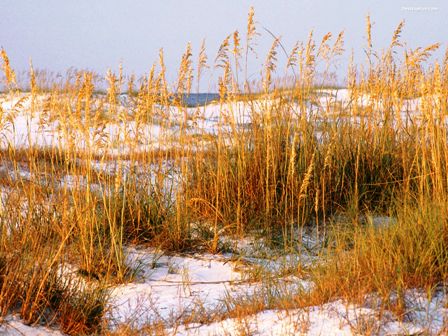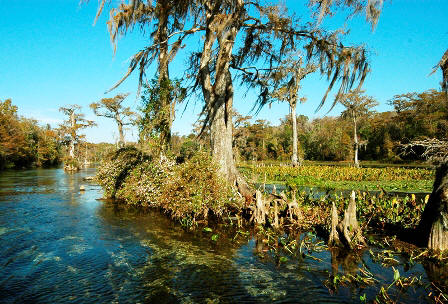Discover Florida Nature
It's time to explore the natural Florida


|
|
|
|
|
 Dunes
and Maritime Forests are part of the Coastal Ecosystem. Florida's coastal
ecosystems are one of the greatest assets that Florida has. With more
coastline than any other state in the contiguous United States, they are
a source of economic, environmental and recreational benefit.
People come from all over the world to visit the beautiful Florida
beaches. In addition to people
sea turtles also come from all over the world to lay their eggs on
Florida's Atlantic coast, one of only a handful of places in the world
that they come. Landward of the fore-dune is the maritime forest. Technically part of the dune
system, this coastal zone habitat has permanent vegetation with tree and
understory layers. Dunes
and Maritime Forests are part of the Coastal Ecosystem. Florida's coastal
ecosystems are one of the greatest assets that Florida has. With more
coastline than any other state in the contiguous United States, they are
a source of economic, environmental and recreational benefit.
People come from all over the world to visit the beautiful Florida
beaches. In addition to people
sea turtles also come from all over the world to lay their eggs on
Florida's Atlantic coast, one of only a handful of places in the world
that they come. Landward of the fore-dune is the maritime forest. Technically part of the dune
system, this coastal zone habitat has permanent vegetation with tree and
understory layers. SUBSTRATE/TOPOGRAPHY: Sandy, sometimes mixed with calcium carbonate; linear barrier islands and some other shorelines along coast; sandy capes; typically contain parallel zones of upper beach, undulating foredune, transition or "backdune," and stable dune, sloping upward and away from the water's edge. VEGETATION / ALGAE: Foredunes contain grasses such as sea oats; a variety of forest vegetation is characteristic of stable dunes: going south from Cape Canaveral on east and from Tampa Bay on west, gradually changes from domination by temperate species to domination by tropical species; at least 22 species of endemic plants are found in dunes and maritime forests FAUNA: Beaches are the most important nesting site for loggerhead turtle in the Western Hemisphere, as well as for several species of shore birds, including the endangered snowy plover; dunes and forests are wintering grounds for many other bird species and habitat for several special-interest species of small rodents. PROCESSES / DYNAMICS / ABIOTIC FACTORS: Wind- and wave-driven sand interact with pioneer grasses to build dunes; waves from hurricanes may destroy dunes. NEGATIVE IMPACTS: Development of beach front, with greatest impacts near Ft. Walton, Jacksonville, Palm Beach, Ft. Lauderdale, Miami, and Clearwater-St. Petersburg; by 1975 nearly 20% of Florida's barrier islands had been developed; exotic plants such as Australian pine, Brazilian pepper, and sisal are also a serious problem.  Maritime
forests dominated by broadleaved evergreen trees and shrubs occur in a
discontinuous narrow band along the barrier islands and on the adjacent
mainland from North Carolina to Florida. The flora and fauna of maritime
forests typically consist of a distinctive subset of the regional biota
that is particularly well adapted to survive the elevated salt content,
limited availability of fresh water, soil erosion and dune migration,
periodic seawater inundation, and wind damage associated with oceanic
storms. Maritime
forests dominated by broadleaved evergreen trees and shrubs occur in a
discontinuous narrow band along the barrier islands and on the adjacent
mainland from North Carolina to Florida. The flora and fauna of maritime
forests typically consist of a distinctive subset of the regional biota
that is particularly well adapted to survive the elevated salt content,
limited availability of fresh water, soil erosion and dune migration,
periodic seawater inundation, and wind damage associated with oceanic
storms. Maritime forests cover the more stable portions of barrier islands and coastal dune ridges. They function as a refuge for wildlife, provide storage capacity for groundwater, and help stabilize the soil. Recent recognition of the relatively greater physical stability of maritime forests compared to the beachfront has resulted in intensified urban development within them. Maritime forests across the range have been increasingly impaired by clearing for roads and parking lots. The beach and dune habitat includes the unvegetated beach, and the dune zone up to the point where the stable vegetation of the maritime forests begin. Landward of the non-vegetated beach zone, is the foredune area. The species inhabiting this zone vary depending on location. Sea oats are found in this zone throughout the state and there will be several other, low growing species in association with this species. Generally, the vegetation is sparse closest to the active beach and transitions to an association of grasses and shrubs. The species composition varies depending on location. Along the northeast beach wax myrtle, silverling, southern red cedar, and cabbage palm are dominant. The southeast coast has purple muhly grass, sea grape, saw palmetto, Spanish bayonet, and agave. nickerbean, bay cedar, catsclaw, buckthorn, lantana, joewood, and several species of grasses dominate the southwest coastline while woody goldenrod, rosemary and Gulf Bluestem make up the dune transition zone in the Panhandle. |
|
|
Advertise | Privacy Statement | Contact | Alaska Nature | Michael Arnold Art| Dog Encyclopedia | Dog Encyclopedia| |
|